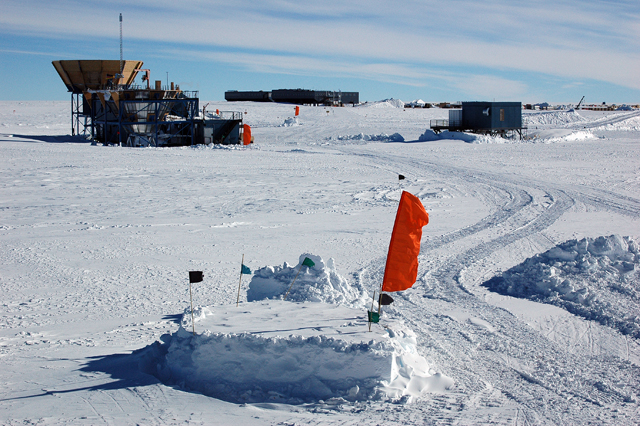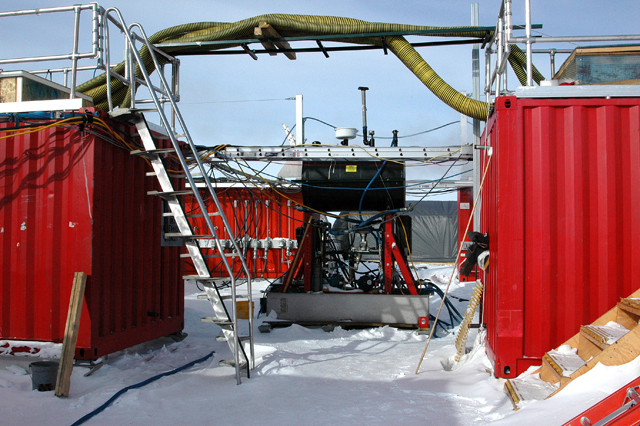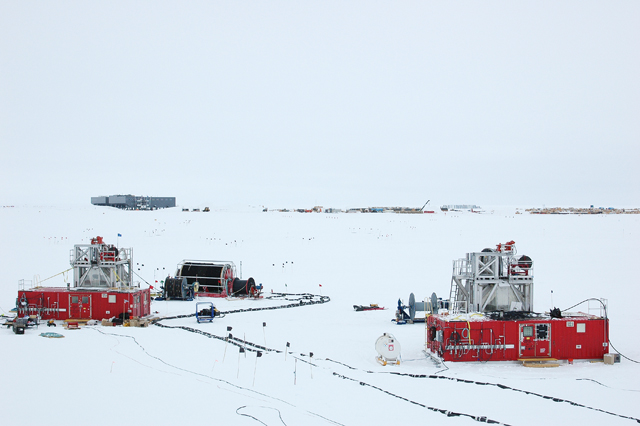Page 2/3 - Posted December 31, 2010
Unexpected ResultsIn fact, even though major construction was just completed, and the final seven strings that were installed this season won’t be fully online until May 2011, the neutrino telescope has been taking data for several years now. Recently, IceCube scientists detected an unusual pattern in cosmic ray intensity toward the Earth’s Southern Hemisphere, with an excess of cosmic rays detected in one part of the sky and a deficit in another. A similar lopsidedness, called “anisotropy,” has been seen from the Northern Hemisphere by other cosmic ray experiments. [See related story: Background noise.] One possible explanation for the irregular pattern is the remains of an exploded supernova in the Milky Way Galaxy. Additionally, IceCube is recording more than 10,000 neutrinos per year coming from the interaction of the cosmic ray-charged particles within the Earth's atmosphere. But very few of these neutrinos, especially those discovered coming through the Earth from the Northern Hemisphere, are the high-energy particles that the telescope was designed to detect. Jens Dreyer, one of two IceCube personnel who will spend the winter at the South Pole to operate the experiment during the dark, cold months in 2011, said he’s been fortunate to see one such event. In the previous winter, his predecessors only detected three during the eight months of winter isolation. “The more energetic an event, the more rare it is,” Dreyer said. Proof of conceptThat such an experiment could even be attempted is an equally rare event. And it all started more than 20 years ago. In 1987, Francis Halzen It then took about 10 years to make the now-famous AMANDA experiment work. Construction of the Antarctic Muon and Neutrino Detector Array was a sort of proof of concept for IceCube. The first detector string for AMANDA went down into South Pole ice in 1993. Four years later, AMANDA recorded the first-ever precision map of a high-energy neutrino event. That’s about the time when Karle got involved. “The most important thing was that it proved this was possible: To use ice as a medium and — what seemed to be a crazy idea — to put sensors 2.5 kilometers underneath the ice,” he said. Still, even with the success of AMANDA, the proposal to build IceCube seemed daunting to many. Remember that the South Pole Station is at the bottom of the world, requiring most materials and fuel to be flown across the continent aboard LC-130 aircraft operated by the New York Air National Guard “It’s amazing we were able to do it. Back in the AMANDA days, we wouldn’t have thought it would have been possible to put in 86 strings in that sort of time,” said Gary Hill, a physicist and lead DOM deployer from Australia. “There’s a big sense of satisfaction that we were able to pull it off in the end,” he added. “Now we look forward to seeing the data that comes from it. It’s a mixture of emotions, but positive. It’s time to move on with it.” Back 1 2 3 Next |



For USAP Participants |
For The Public |
For Researchers and EducatorsContact UsU.S. National Science FoundationOffice of Polar Programs Geosciences Directorate 2415 Eisenhower Avenue, Suite W7100 Alexandria, VA 22314 Sign up for the NSF Office of Polar Programs newsletter and events. Feedback Form |





